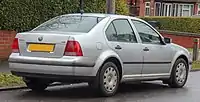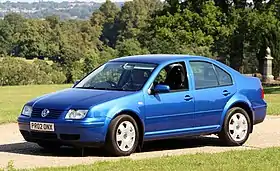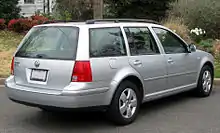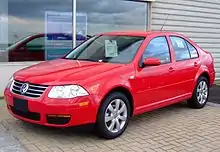Volkswagen Bora
The Volkswagen Bora is a small family car, the fourth generation of the Volkswagen Jetta, and the successor to the Volkswagen Vento. Production of the car began in July 1999.[3] Carrying on the wind nomenclature from previous generations, the car was known as the Volkswagen Bora in much of the world. Bora is a winter wind that blows intermittently over the coast of the Adriatic Sea, as well as in parts of Greece, Russia, Turkey, and the Sliven region of Bulgaria. In North America and South Africa, the Volkswagen Jetta moniker was again kept on due to the continued popularity of the car in those markets.

| Volkswagen Bora (A4, Typ 1J) | |
|---|---|
 2002 Volkswagen Jetta, 1984 cc | |
| Overview | |
| Also called | Volkswagen Jetta Volkswagen City Jetta (Jetta City in 2009) Volkswagen Bora Classic Edition (China) Volkswagen Clásico (2010 onwards in Mexico) |
| Production | 1999–2006 (Europe) 1999–2015 (Mexico) 2001–present (China) |
| Model years | 1999–2007 (US, Canada, Europe) 2000–2015 (Argentina |
| Assembly | Wolfsburg, Germany[1] Bratislava, Slovakia[1] Changchun, China (FAW-VW)[1] Puebla, Mexico[2] Uitenhage, South Africa[1] |
| Body and chassis | |
| Body style | 4-door notchback sedan / saloon 5-door wagon / estate |
| Layout | Front-engine, front-wheel-drive or four-wheel-drive |
| Platform | Volkswagen Group A4 (PQ34) platform |
| Related | Volkswagen Golf Mk4 Audi A3 Mk1 SEAT León Mk1 SEAT Toledo Mk2 Škoda Octavia Mk1 |
| Powertrain | |
| Engine | 1.4 L I4 (petrol) 1.6 L I4 16-valve (petrol) 1.8 L I4 20-valve turbo (petrol) 2.0 L I4 (petrol) 2.3 L VR5 10-valve (petrol) 2.3 L VR5 20-valve (petrol) 2.8 L VR6 12-valve (petrol) 2.8 L VR6 24-valve (petrol) 1.9 L I4 SDI (diesel) 1.9 L I4 TDI (diesel) |
| Transmission | 5-speed manual (02J) 6-speed manual (02M) 4-speed automatic (01M) 5-speed automatic (09A) 6-speed automatic (09G) |
| Dimensions | |
| Wheelbase | sedan: 2,510 mm (98.8 in) estate: 2,520 mm (99.2 in) |
| Length | sedan: 4,380 mm (172.4 in) estate: 4,410 mm (173.6 in) |
| Width | 1,730 mm (68.1 in) |
| Height | sedan: 1,440 mm (56.7 in) estate: 1,490 mm (58.7 in) '08 City Jetta sedan: 1,445 mm (56.9 in) |
| Chronology | |
| Predecessor | Volkswagen Vento (A3) |
| Successor | Volkswagen Jetta (A5) |
The Mk4 debuted shortly after its larger sibling, the Passat, with which it shared many styling cues. The rounded shape and arched roofline served as the new Volkswagen styling trademark, abandoning traditional sharp creases for more curved corners. A distinguishing feature of the Mk4 is its Whiptenna, a trademark for the antenna on the rear end of the roof, which claims to incur less drag than traditional antennae due to its short length and leeward position. For the first time, the rear passenger doors differed from those of a five-door Golf. The car was also offered as an estate/wagon (whose rear doors are also not interchangeable with the others). New on this generation were some advanced options such as rain sensor-controlled windshield wipers and automatic climate control. However, these were expensive extras and many buyers did not specify them on their cars; as a result, the used market has many sparsely equipped models.
Although slightly shorter overall than the Mark 3, the fourth generation had the wheelbase extended slightly. Some powertrain options were carried over. Nevertheless, two new internal-combustion engines were offered, the 1.8-litre turbo four-cylinder (often referred to as the 1.8 20vT), and the VR6. The suspension setup remained much as before. However, it was softened considerably in most models to give a comfortable ride, which was met with some criticism as it was still quite hard in comparison with rivals such as vehicles offered from French carmakers.[4]
Diesel

In 2004, a new range of "Pumpe-Düse" Unit Injector diesel engines was offered. This new design employed advanced unit injectors, along with additional electronics and emissions equipment to meet new emissions standards in Europe and North America, and is considerably more complex than the older diesel engines previously offered. To accomplish the task of producing sufficient power while meeting emissions standards, the "PD" technology injects fuel directly into the combustion chamber at pressures up to an incredibly high 2,050 bar (30,000 psi).[5] The purpose of the high pressure is to promote fine atomisation of the fuel, which supports more complete combustion. To reduce noise, the engine employs a "pilot injection" system that injects a small amount of fuel prior to the main injection. All of the new generation of diesel engines require a special motor oil to meet Volkswagen oil specification 505.01 (or newer). Serious damage to the engine, particularly the camshaft and injectors, will result if oil not meeting this standard is used.
Safety
Safety on the fourth-generation cars was a high priority for Volkswagen.[6] The car was built using such advanced processes as highly mechanised presses, improved measuring techniques, and laser welding of the roof. In crash tests, the fourth-generation car received very good marks. In the New Car Assessment Program tests conducted by the National Highway Traffic Safety Administration, the car received five out of five stars for both driver and passenger protection in a 56-km/h (35-mph) frontal impact.[7] New side-impact tests at 62 km/h (38.5 mph) awarded the car four out of five stars for both driver and rear-seat passenger protection. Side-curtain airbags became standard in the 2001 model year. In the more severe 64-km/h (40-mph) offset test conducted by the Insurance Institute for Highway Safety, the Mark 4 was awarded the highest score of "Good".[8] Injury, collision, and theft losses were low for a car of its class.[9]
Testing and review
Critics usually found the fourth generation acceptable. The car was praised for its adequate handling and a moderately comfortable ride.[10] Other reviewers noted the car to be an ugly and somewhat expensive choice in the compact-car segment, some simply referred to it as a Golf with a boot (trunk) on the back added as a last-minute addition.[11] Some complaints were made that the back seats lacked adequate room for two adults.[12] Some found the seat cushioning too firm. The interior was praised for the high level of fit, but is quite bland, sparsely equipped, and uninspiring.[13] New in this generation was Volkswagen's signature blue and red instrument lighting, which became standard in all models in 1999. The climate controls were placed low on the console. The recirculation mode cannot be turned on when air is vented to the windshield, and if the driver changes the climate control to vent air to the windshield, an internal mechanism would turn off the recirculation mode. The power outlet is recessed next to the ash tray and is covered with two flaps, one of which is shared with the ash tray. Retractable cup holders were placed directly above the stereo, obscuring vision of the stereo display and allowing beverages to spill on the stereo, gear selector, and other sensitive components during erratic vehicle movements. The flimsy plastic construction of the retractable cup holder is likely to fail with normal use. Rear passengers have a pair of retractable cup holders located under the cylindrical ash tray on the center console. These problems were rectified in 2003 for the US market by placing two recessed cup holders in tandem in the center console and another behind the arm rest pedestal for rear passengers. The driver must raise the arm rest to access the center cup holder, and a large beverage occupying the front cup holder obstructs the driver's ability to pull the hand brake. European cars were given a redesigned retractable cup holder in front.
Drivers complained that the front bumper cover does not have adequate ground clearance to clear a curb in a parking space. In addition to scratching the cover, if the driver drives the Jetta too far forward into a parking space, the bumper cover would have a tendency to hook onto the curb like a barb, and as the driver backs out of the parking space, the entire front bumper cover would be torn off the vehicle. In the US, a class-action lawsuit regarding this problem was filed in 2009,[14] and a settlement was reached awarding owners a $140 reimbursement for repair costs.[15]
The earlier US models have a few quality-control issues, as a number of owners reported windows falling into the doors, electrical problems, body panels rusting from the inside out, especially on the front wheel arches and wagon lift door, and emissions system defects.[16][17] The fourth generation takes approximately 52 hours per vehicle to assemble in the Puebla factory.[18]
Engines
| Model | Years | Engine and code | Displacement | Power | Torque | |
|---|---|---|---|---|---|---|
| 1.4 | 1998–2005 | I4 16V | AHW/AXP/BCA | 1,390 cc (85 cu in) | 55 kW (74 hp; 75 PS) @ 5,000 rpm | 126 N⋅m (93 lb⋅ft) @ 3,800 rpm |
| 1.6 | 1998–2000 | I4 8V | AEH/AKL/APF | 1,595 cc (97.3 cu in) | 74 kW (99 hp; 101 PS) @ 5,600 rpm | 145 N⋅m (107 lb⋅ft) @ 3,800 rpm |
| 1.6 | 2000–2005 | I4 8V | AVU/BFQ | 1,595 cc (97.3 cu in) | 75 kW (101 hp; 102 PS) @ 5,600 rpm | 148 N⋅m (109 lb⋅ft) @ 3,800 rpm |
| 1.6 | 2000–2005 | I4 16V | AUS/AZD/ATN/BCB | 1,598 cc (97.5 cu in) | 77 kW (103 hp; 105 PS) @ 5,700 rpm | 148 N⋅m (109 lb⋅ft) @ 4,500 rpm |
| 1.6 FSI | 2001–2005 | I4 16V | BAD | 1,598 cc (97.5 cu in) | 81 kW (109 hp; 110 PS) @ 5,800 rpm | 155 N⋅m (114 lb⋅ft) @ 4,400 rpm |
| 2.0 | 1998–2001 | I4 8V | APK/AQY | 1,984 cc (121.1 cu in) | 85 kW (114 hp; 116 PS) @ 5,200 rpm | 170 N⋅m (125 lb⋅ft) @ 2,400 rpm |
| 2.0 | 2001–2005 | I4 8V | AVH/AZG/AZH/BEV | 1,984 cc (121.1 cu in) | 85 kW (114 hp; 116 PS) @ 5,400 rpm | 172 N⋅m (127 lb⋅ft) @ 3,200 rpm |
| 1.8 | 2001–2005 | I4 20V | AGN/BAF | 1,781 cc (108.7 cu in) | 92 kW (123 hp; 125 PS) @ 5,900 rpm | 170 N⋅m (125 lb⋅ft) @ 3,500 rpm |
| 1.8 T | 2000–2005 | I4 20V | AWD/AWW/BAE | 1,781 cc (108.7 cu in) | 110 kW (148 hp; 150 PS) @ 5,700 rpm | 210 N⋅m (155 lb⋅ft) @ 1,750–4,600 rpm |
| 2.3 V5 | 1998–2001 | VR5 10V | AGZ | 2,324 cc (141.8 cu in) | 110 kW (148 hp; 150 PS) @ 6,200 rpm | 209 N⋅m (154 lb⋅ft) @ 3,300 rpm |
| 2.8 V6 | 1999–2002 | VR6 12V | AAA/AFP | 2,792 cc (170.4 cu in) | 132 kW (177 hp; 179 PS) @ 5,800 rpm | 245 N⋅m (181 lb⋅ft) @ 3,200 rpm |
| 2.3 V5 | 2000–2003 | VR5 20V | AQN | 2,324 cc (141.8 cu in) | 125 kW (168 hp; 170 PS) @ 6,200 rpm | 220 N⋅m (162 lb⋅ft) @ 3,300 rpm |
| 1.8 T | 2001–2005 | I4 20V | AUQ | 1,781 cc (108.7 cu in) | 132 kW (177 hp; 179 PS) @ 5,500 rpm | 235 N⋅m (173 lb⋅ft) @ 1,950–5,000 rpm |
| 2.8 V6 | 2001–2004 | VR6 24V | AQP/AUE/BDE | 2,792 cc (170.4 cu in) | 150 kW (201 hp; 204 PS) @ 6,000 rpm | 270 N⋅m (199 lb⋅ft) @ 3,200 rpm |
| 1.9 SDI | 1998–2005 | I4 8V | AGP/AQM | 1,896 cc (115.7 cu in) | 50 kW (67 hp; 68 PS) @ 4,200 rpm | 133 N⋅m (98 lb⋅ft) @ 2,200–2,600 rpm |
| 1.9 TDI | 1998–2003 | I4 8V | AGR/ALH | 1,896 cc (115.7 cu in) | 66 kW (89 hp; 90 PS) @ 3,750 rpm | 210 N⋅m (155 lb⋅ft) @ 1,900 rpm |
| 1.9 TDI | 2000–2005 | I4 8V | ATD/AXR | 1,896 cc (115.7 cu in) | 74 kW (99 hp; 101 PS) @ 4,000 rpm | 240 N⋅m (177 lb⋅ft) @ 1,800–2,400 rpm |
| 1.9 TDI | 1998–2001 | I4 8V | AHF/ASV | 1,896 cc (115.7 cu in) | 81 kW (109 hp; 110 PS) @ 4,150 rpm | 235 N⋅m (173 lb⋅ft) @ 1,900 rpm |
| 1.9 TDI | 1998–2000 | I4 8V | AJM | 1,896 cc (115.7 cu in) | 85 kW (114 hp; 116 PS) @ 4,000 rpm | 285 N⋅m (210 lb⋅ft) @ 1,900 rpm |
| 1.9 TDI | 1999–2001 | I4 8V | AUY | 1,896 cc (115.7 cu in) | 85 kW (114 hp; 116 PS) @ 4,000 rpm | 310 N⋅m (229 lb⋅ft) @ 1,900 rpm |
| 1.9 TDI | 2001–2005 | I4 8V | ASZ | 1,896 cc (115.7 cu in) | 96 kW (129 hp; 131 PS) @ 4,000 rpm | 310 N⋅m (229 lb⋅ft) @ 1,900 rpm |
| 1.9 TDI | 2000–2005 | I4 8V | ARL | 1,896 cc (115.7 cu in) | 110 kW (148 hp; 150 PS) @ 4,000 rpm | 320 N⋅m (236 lb⋅ft) @ 1,900 rpm |
Bora Variant (estate version)

Volkswagen introduced an estate/station wagon version of the fourth-generation car in January 2001 at the Los Angeles Auto Show.[19] This was the first time an "A" platform Volkswagen was available in North America with that body style. Although the sedan was built in a number of locations, all Jetta estate models were built in the Wolfsburg plant.[20] In the rear, 963 l (34 ft3) of space were available in the cargo compartment. When the rear seats were folded, the car could hold 1473 l (52 ft3). Like the sedan, the estate/wagon received high marks from most reviewers.[21][22] They noted that the cargo area was large and useful. Additionally, the interior kept its top-quality fit and finish, although the rear seat was still a bit small.
In Europe, the estate version was sometimes sold as part of the Golf line, either in addition to or instead of the Bora. Other than different front bumpers, fenders, headlights, and hood, the cars were identical. In some countries, both Golf Variant and Bora Variant were sold.
Ongoing production

.jpg.webp)
As of 2008, the fourth-generation car is still sold in addition to the newer Mark 5, due to higher pricing of the fifth generation in some countries such as Colombia, China, Canada, Dominican Republic, Mexico, Brazil, and Argentina. Like its second-generation predecessor, the Mark 4 continues to be manufactured and marketed in China by Volkswagen Group's joint venture partner FAW-Volkswagen.
In October 2006, Volkswagen re-released the fourth-generation car in Canada (for the 2007 model year) as the City Jetta.[23] The move was made to allow Volkswagen to be more competitive with the rest of the compact class as the fifth-generation Jetta had moved upscale versus much of the competition. In 2008, the car was restyled to bring its looks up to date with the rest of the Volkswagen lineup. The only engine available was the 2.0-l, eight-valve SOHC 85 kW (116 PS; 114 hp) gasoline four-cylinder with an available six-speed tiptronic (with Sport mode) that was added as an option in 2008. In 2009, both model names were changed to Jetta City and Golf City. The Jetta City (since 2010 MY) and Golf City (since 2011 MY) are now both discontinued. The City Jetta is built alongside the fifth generation in the Puebla Assembly Plant.
In Mexico, the fourth-generation Jetta has been Volkswagen's most successful model for years, peaking in June 2009 on the top in sales and being fourth as of October 2009, just below Nissan's Tsuru (Sentra B13), Chevrolet's Chevy (Opel Corsa B) and the Brazilian Volkswagen Golf. Nevertheless, it is the best-selling compact car in the country. Volkswagen decided to keep sales along with the Bora (Jetta V, which is the fifth-best seller) with the tagline Why do we want a Jetta? Because the heart gives no reasons. In October 2010, the name "Jetta" was dropped, and the simpler name "Clasico" (Spanish for "classic") was chosen, suggesting this model may still be offered for years to come. In the model range, a 1.8-l 133 kW (178 hp; 181 PS) turbo in the Clasico GLI and a TDI 1.9-l 75 kW (101 hp; 102 PS) engine are available. After the 2013 model year, the Clasico lineup was reduced to a single trim level, which is the base model called CLasico CL Aire (which means it is equipped with air conditioning). The GLI and TDI were also discontinued. The CL Aire trim level features 15-inch steel wheels with full covers. Antilock brakes and front airbags are available in manual, and automatic transmissions are optional. The 2014 model was the last to be produced in Puebla, Mexico, but some of the remaining units were still sold as 2015 models.
See also
References
- ETKA
- Volkswagen Group. "Volkswagen Group 50 years of Volkswagen de México". Archived from the original on 8 April 2016. Retrieved 29 March 2016.
- Grieger, p. 168
- Simister, John; Morgan, Andy (October 2003). "VW Golf 2.0 FSI". evo Car Reviews. Dennis Publishing Limited. Retrieved 29 May 2007.
- "Volkswagen Diesel Technology" (Press release). Volkswagen AG. 7 April 2004. Archived from the original on 30 November 2007. Retrieved 3 September 2009.
- Grieger, p. 150
- "NCAP ratings for tested vehicles". National Highway Traffic Safety Administration. 2000. Archived from the original on 5 February 2008. Retrieved 3 September 2009.
- "Frontal Offset Test". Insurance Institute for Highway Safety. 1999. Retrieved 15 April 2007.
- "Injury, Collision, & Theft Losses" (PDF). Highway Loss Data Institute. September 2005. Archived from the original (PDF) on 8 May 2007. Retrieved 3 September 2009.
- Brown, Warren (10 January 1999). "A Car to Touch the Soul". The Washington Post. pp. C.25.
- "Consumer Reports". May 1999: 55. Cite journal requires
|journal=(help) - Harper, Brian (October 1999). "Jetta TDI, the miser: Review". National Post. pp. E.12.
- Kenzie, Jim (11 September 2004). "Well-dressed Jetta wagon worth $37,000". Toronto Star. pp. G.23.
- Hess v. Volkswagen of America, INC. Justia US Law
- "Archived copy". Archived from the original on 22 March 2014. Retrieved 21 March 2014.CS1 maint: archived copy as title (link)
- "Volkswagen Jetta Windows". 2003–2007. Retrieved 15 April 2007.
- "VW Fined $1.1 Million for Clean Air Violations". 15 June 2005. Retrieved 15 April 2007.
- "Harbour Report" (PDF) (Press release). Harbour Consulting Inc. 31 May 2007. Archived from the original (PDF) on 3 July 2007. Retrieved 3 September 2009.
- Williams III, G. Chambers (2 March 2001). "Definitely not your father's . . . . . . station wagon". Milwaukee Journal Sentinel. pp. 01.S.
- "Volkswagen of America Concentrates on Process Rolls out new, dealer-friendly distribution system". January 2002. Archived from the original on 17 April 2007. Retrieved 3 September 2009.
- "Consumer Reports". August 2002. Cite journal requires
|journal=(help) - "JETTA WAGON: FUN, WITH SOME GLITCHES". Pittsburgh Post-Gazette. 11 July 2003. pp. C.2.
- Wilson, Greg (20 September 2006). "Preview: 2007 Volkswagen City Golf & City Jetta". Canadian Driver.
External links
 Media related to Volkswagen Bora I at Wikimedia Commons
Media related to Volkswagen Bora I at Wikimedia Commons Media related to Volkswagen Jetta IV at Wikimedia Commons
Media related to Volkswagen Jetta IV at Wikimedia Commons
